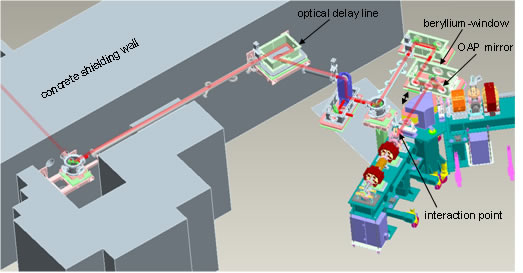Demonstration of the production of Compton backscattering X-rays (CBS) was one of the first goals of ALICE, achieved in 2009.
Inverse Compton scattering is a promising method to implement a high-brightness, ultra-short, energy tuneable X-ray source at accelerator facilities and at laser facilities using laser wake field acceleration. At ALICE an inverse Compton X-ray source was developed, driven by the multi teraWatt laser installed at Daresbury Laboratory. In the CBS source at ALICE, polarised X-ray pulses are generated through the interaction of laser pulses with electron bunches delivered by the energy recovery.
The expected proporties of the X-rays from CBS are as follows. The X-rays produced have spectral peaks ranging from 0.4 to 12 nanometers, depending on the electron bunch energy and the scattering geometry. X-ray pulses containing up to 107 photons per pulse are created from head-on collisions, with a pulse duration comparable to the incoming electron bunch length. For transverse collisions the laser pulse transit time defines the X-ray pulse duration. The peak spectral brightness is predicted to be up to 1021 photons/s mm2 mrad2 0.1%.
The CBS project was called COBALD, and was a proof of principle project, rather than a project to provide CBS X-rays on a continual basis at ALICE. CBS X-rays were demonstrated in 2009. One of the principle challenges of the project was extreme accuracy of photon/electron beam synchronization, which is a fundamental requirement for all conventional accelerator and laser wake field acceleration based sources.
You can find more scientific details on the CBS demonstration in 2009 in a journal in the proceedings of the SPIE conferences. (link opens in a new window)

Laser beam transport line through the concrete shielding wall to the interaction region.
